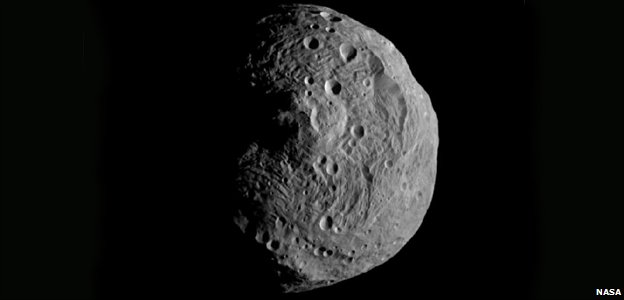
The pictures reveal the ancient body's craters, slopes and grooves in detail that is far beyond the vision of Earth-bound telescopes, including Hubble.
Dawn scientists will have a busy year interpreting the asteroid's features.
They will be looking for some fresh insight on how such objects came into being 4.6 billion years ago.
It is often said the asteroids, which dominate a region of space between Mars and Jupiter, are the rubble that was left over after the planets proper had formed.
"We are beginning the study of arguably the oldest extant primordial surface in the Solar System," said Dawn's principal investigator Christopher Russell from the University of California, Los Angeles.
"This region of space has been ignored for far too long. So far, the images received to date reveal a complex surface that seems to have preserved some of the earliest events in Vesta's history, as well as logging the onslaught that Vesta has suffered in the intervening eons."
Dawn's quest at Vesta over the coming months is to undertake a comprehensive survey.
The probe carries instruments to detect the mineral and elemental composition of its surface rocks. It will be looking for evidence of geological processes such as mountain building and rifting. The Dawn science team is keen to understand how Vesta's surface has been remodelled over time by impacts and even lava flows.
Dawn's remote sensing instruments will also be able to discern something of the asteroid's internal structure. The expectation is that scientists will confirm it has a metallic core.
From the outside, Vesta looks like a punctured football, the result of a colossal collision sometime in its past that knocked off its south polar region.
Much of the rock that was liberated in that mighty impact has found its way to Earth, falling to the ground as meteorites.
Dawn was launched by the US space agency almost four years ago.
The probe, which is propelled by an ion engine, allowed itself to be captured in the gravitational field of Vesta on Saturday.
Although initially orbiting the rock at several thousand km, Dawn will move closer over time - perhaps to within 200km if navigators are confident there is no risk to the spacecraft.
Once it has completed its work at Vesta, the probe will move on to the even bigger rock, Ceres. With a diameter of roughly 950km, this world has a much more rounded shape and is classed as a "dwarf planet", the same designation now ascribed to Pluto.



Reader Comments
to our Newsletter